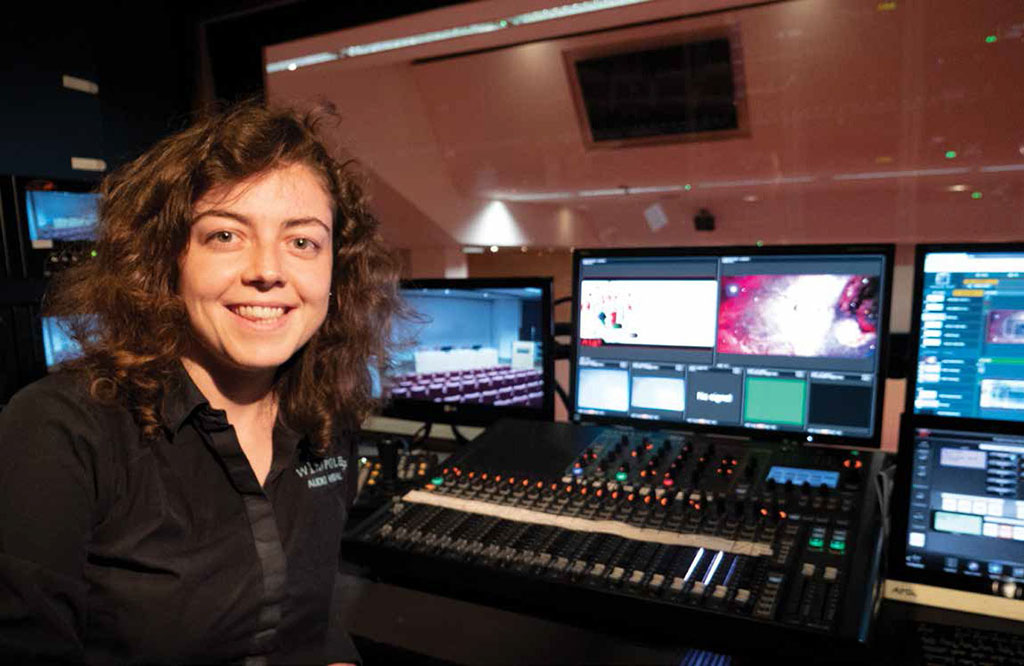Different forces pull us into technology careers. For Madeleine Vining, audio was the hook.
“I studied music technology as a degree,” said Vining, a senior AV technician at 1 Wimpole Street, London’s premier live-event venue. With her musical aspirations and love of audio, a career in the sound industry was the natural next step.
Working at the 2012 London Olympics, however, where she was trained in utilities—operating sound, setting up cameras, and assisting with live camera feeds—she had a eureka moment. “As much as I love audio,” she confessed, “I realized that want to do something more broad, including video. I knew I could do more.”
ENTHUSIASM FOR AV
In the six years since the Olympics, Vining has been a rising star in the AV industry, winning a 2016 InstallAward and becoming proficient in sound engineering, camera operation, video editing, live streaming, interactive meeting technologies, troubleshooting AV in live events, networked AV systems, and IT support. Part of her ascendency track was joining the AV team at London’s 1 Wimpole Street, Royal Society of Medicine.
“I saw a trainee AV technician job come up here, at the Royal Society of Medicine. Thought I’d give it a go for the interview. Luckily, they liked me and they hired me, and that’s where I’ve worked ever since.”
She has progressed from training up to announcing and technology upkeep, and “it’s been very good,” Vining said. The award-winning AV team of eight at the Royal Society of Medicine includes Kevin McLoughlin, winner of the AV Awards 2016 “AV Professional of the Year.”
Vining enthused that whole team enjoys AV technology on a sincere and deep level, so “it’s nice if we go out as a group, it’s like, ‘Oh, look at the display there.’”
A DYNAMIC INDUSTRY: “IT’S ALWAYS DIFFERENT”
No matter your role in the AV industry, one thing is certain—every day brings a new challenge. Vining enjoys the confluence of problem solving and agile thinking.
“Work is always different, depending on the events we’ve got on, whether it’s internal or external,” she said. “Beyond my usual tasks, such as video editing or setting up the live streams, we attend meetings, production meetings, and client visits [to plan for future events]. I check that the technicians are supported, that all our equipment is functioning well.”
If there are performance or equipment issues, Vining will help troubleshoot. Usually everything is “working fine,” Vining confessed, but it’s still important to lend support if and when it’s needed so that all programs run flawlessly.
A MARKETPLACE OF IDEAS
Another benefit to a career in professional AV is the culture of learning and sharing.
“It’s really nice to teach and share my knowledge with someone who may not know a technology as well,” Vining noted.
While some stakeholders argue that the AV industry is not as “mature” as IT, this element inspires technicians like Vining to be resourceful, tenacious, and focused.
“Everyone has certain ways of doing things,” she said, and it is fascinating to see how people bring different skills and perspectives to the same problem.
TRAINING AND EXPERIENCE
New AV products hit the global market every quarter, making it difficult to stay on top of the latest software iteration or newest suite extension. Regular product demonstrations, trade shows, and site visits help the Royal Society of Medicine AV team stay in the know.
“We try to attend as many trade shows as we can,” Vining said, “and get product demos. We also visit a lot of other venues. That’s what’s great about the AV User Group, Women in AV, and AVIXA Women’s Council: you can see different venues and experience what they have. You can speak to their AV technicians or managers, and just learn from them, hearing about what they use, what problems they’ve had.”
The AV team also welcomes manufacturers and distributors to its venue for live, on-site training.
AV OVER IP: “IT JUST MAKES SENSE”
AV/IT convergence is trending at commercial facilities across the world, and 1 Wimpole Street is no exception.
“Our audio network system is quite interesting because it’s got AVB and Dante. We just got rid of our last Cobranet channel, which is good.”
While the team is not using video over IP at the moment, they are “hoping for it in the future,” Vining said.
“We’ve got a project in 2020, so obviously, to be able to send video over IP, we need a major infrastructure change. We need network switches. We need to do a lot of work before we can do video, but we want to. And, currently, all our audio is DSP.”
Vining shared that she appreciates how an IP-based system makes everything centralized and more accessible.
“The way we’ve got our Biamp Tesira set up, we’re able to access all three auditoriums,” she said. “If you need to patch something, it’s very easy to do it, as long as it’s patched on the desk as well. To do it via the Tesira software, rather than having to go over to an auditorium and manually change tables, it saves time and it’s quite intuitive. It’s all visible there, so you can automatically see if there’s a problem.”
Since Vining entered the industry as networked AV was catching traction, the IP methodology and sensibility feel natural. In fact, she doesn’t know the alternative.
“I find [IP] quite easy; it makes sense. It’s also what I am used to. For some, it might be a big change. It’s just how you perceive it, though, and if you’re willing to learn it and try something new.”
Beyond the centralization of control, the ability to remotely monitor signals and feeds is useful. The team can ascertain if there is a signal problem because of an EDID issue, for example.
“Being able to remotely control something in another room is good, and I feel like that was a great progression with audio. Going forward, I think a lot of AV work will be via IP, checking and adjusting remotely rather than physically going up to a unit and changing it.”
Network-based AV also helps staff solve problems faster, make more informed decisions, and stay proactive.
“Just today, a warning message popped up on our control system saying our projector was getting too hot. It is helping us save time by checking [for failures] in one place rather than all sorts of places.”
VIDEO ON THE NETWORK
Bringing video on the network is the next level of AV over IP, and a reality that Vining and the team are embracing.
“We had a Biamp TesiraLUX demo here with our 4K projector,” she said. “We saw it working and were very impressed. It works well with our Tesira system, so it’s not that hard to implement. We want to build a video studio upstairs, and we shoot a lot of 4K footage, so obviously sending it to and from would be amazing.”
FORECAST: CLOUDY
Vining is also a “big fan of the cloud.” She and the team use Adobe Premiere for editing, and cloud access is a major convenience. The cloud also increases efficiencies.
“I can access it from home, I can access it from work. It is something we’ll need to invest in more, moving toward it with our email system and everything. It’s going to take a little bit of work to get the right storage,” but the team believes the cloud is the future.
VIRTUAL MEDICAL EDUCATION AND STREAMING
Another future forecast at the Royal Society of Medicine is virtual reality (VR).
“VR is a great way of teaching medical professionals. Hopefully, if we have enough money and enough interest, that’s something we’d be able to invest in.”
Also, the nature of 1 Wimpole Street / Royal Society of Medicine lends itself to live streaming, and the team is eager to do more.
“We’ve done a few live streams in the medical field, such as [partnering with] a dental surgery. We’ve live streamed it back to ourselves, and from here we have also live-streamed certain medical procedures.”
SHOW INITIATIVE, STAY CURIOUS
For the next generation of AV professionals, Vining has some advice. “Get as much experience and exposure as possible. Go to trade shows,” she suggested. “See different venues. If you’re lucky enough, find a mentor who can help you and advise you.”
It’s also important to stay motivated. Be a self-starter. “Some focus on hiring people that have all the skillsets needed for AV, but I think quite a bit of it can be trained, but only if you want to know it.” There is a big difference between someone who looks great on paper and an individual who has a “can-do attitude and initiative.”
What really sets an AV technologist apart is passion and a perennial sense of curiosity. “AV is like a mentality,” Vining opined, and one that extends beyond the nine-to-five workday. “It’s like when you walk into a room and you notice the keystoning is off,” she laughed, “or there is a frequency that shouldn’t be there.”
If Madeleine Vining is the example, the future of AV will be about much more than technology. It will be an appreciation for elevating shared spaces and creating more meaningful experiences.
Margot Douaihy is the editor-at-large of AV Technology and an instructor at Franklin Pierce University.
AR in Higher Ed
MAKING NEW CONNECTIONS
Augmented reality (AR) holds exciting potential in higher education and medical education. In Maryland’s Washington College Augmented Archives, for example, AR is offering an engaging way to study fragile artifacts that would normally be restricted or protected inside a glass case. The college’s Augmented Archives, an interdisciplinary collaboration that reflects a broader institutional embrace of emerging technology, lets visitors and viewers interact with the collection’s precious materials and 3D representations of objects. It’s a type of active engagement that simply wouldn’t be possible in the “real world.”
Medical school instructors and technologists are also keen to invest in AR and its emerging technology cousin, VR (virtual reality), to enhance learning environments. AR superimposes virtual organs and virtual patients, with correct sizes and proportions, so medical students can examine and explore biology in context. As The Royal Society of Medicine’s Madeleine Vining sees it, “VR and AR is a great way of teaching medical professionals. Hopefully, if we have enough money and enough interest, that’s something we’d be able to invest in.” Learn more about the Washington College Augmented Archives via https://www.washcoll.edu.

